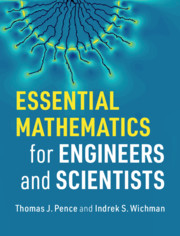Refine search
Actions for selected content:
6993 results in Mathematical modeling and methods
Frontmatter
-
- Book:
- Essential Mathematics for Engineers and Scientists
- Published online:
- 30 April 2020
- Print publication:
- 21 May 2020, pp i-iv
-
- Chapter
- Export citation
Dedication
-
- Book:
- Essential Mathematics for Engineers and Scientists
- Published online:
- 30 April 2020
- Print publication:
- 21 May 2020, pp v-vi
-
- Chapter
- Export citation
5 - Complex Variables: Basic Concepts
- from Part II - Complex Variables
-
- Book:
- Essential Mathematics for Engineers and Scientists
- Published online:
- 30 April 2020
- Print publication:
- 21 May 2020, pp 191-234
-
- Chapter
- Export citation
References
-
- Book:
- Essential Mathematics for Engineers and Scientists
- Published online:
- 30 April 2020
- Print publication:
- 21 May 2020, pp 729-731
-
- Chapter
- Export citation
Part I - Linear Algebra
-
- Book:
- Essential Mathematics for Engineers and Scientists
- Published online:
- 30 April 2020
- Print publication:
- 21 May 2020, pp 1-2
-
- Chapter
- Export citation
Preface
-
- Book:
- Essential Mathematics for Engineers and Scientists
- Published online:
- 30 April 2020
- Print publication:
- 21 May 2020, pp xiii-xvii
-
- Chapter
- Export citation
About the Authors
-
- Book:
- Essential Mathematics for Engineers and Scientists
- Published online:
- 30 April 2020
- Print publication:
- 21 May 2020, pp xx-xx
-
- Chapter
- Export citation
Part II - Complex Variables
-
- Book:
- Essential Mathematics for Engineers and Scientists
- Published online:
- 30 April 2020
- Print publication:
- 21 May 2020, pp 189-190
-
- Chapter
- Export citation
13 - Combined Green’s Function and Eigenfunction Methods
- from Part III - Partial Differential Equations
-
- Book:
- Essential Mathematics for Engineers and Scientists
- Published online:
- 30 April 2020
- Print publication:
- 21 May 2020, pp 666-728
-
- Chapter
- Export citation
6 - Analytic Functions of a Complex Variable
- from Part II - Complex Variables
-
- Book:
- Essential Mathematics for Engineers and Scientists
- Published online:
- 30 April 2020
- Print publication:
- 21 May 2020, pp 235-301
-
- Chapter
- Export citation
4 - The Spectrum of Eigenvalues
- from Part I - Linear Algebra
-
- Book:
- Essential Mathematics for Engineers and Scientists
- Published online:
- 30 April 2020
- Print publication:
- 21 May 2020, pp 128-188
-
- Chapter
- Export citation
2 - Linear Transformations
- from Part I - Linear Algebra
-
- Book:
- Essential Mathematics for Engineers and Scientists
- Published online:
- 30 April 2020
- Print publication:
- 21 May 2020, pp 52-91
-
- Chapter
- Export citation
A MODIFIED IMMERSED FINITE VOLUME ELEMENT METHOD FOR ELLIPTIC INTERFACE PROBLEMS
- Part of
-
- Journal:
- The ANZIAM Journal / Volume 62 / Issue 1 / January 2020
- Published online by Cambridge University Press:
- 13 May 2020, pp. 42-61
-
- Article
-
- You have access
- Export citation

Essential Mathematics for Engineers and Scientists
-
- Published online:
- 30 April 2020
- Print publication:
- 21 May 2020
-
- Textbook
- Export citation
ANZ VOLUME 61 ISSUE 4 COVER AND BACK MATTER
-
- Journal:
- The ANZIAM Journal / Volume 61 / Issue 4 / October 2019
- Published online by Cambridge University Press:
- 24 April 2020, pp. b1-b9
-
- Article
-
- You have access
- Export citation
ANZ VOLUME 61 ISSUE 4 COVER AND FRONT MATTER
-
- Journal:
- The ANZIAM Journal / Volume 61 / Issue 4 / October 2019
- Published online by Cambridge University Press:
- 24 April 2020, pp. f1-f2
-
- Article
-
- You have access
- Export citation
THE ALTERNATIVE KIRCHHOFF APPROXIMATION IN ELASTODYNAMICS WITH APPLICATIONS IN ULTRASONIC NONDESTRUCTIVE TESTING
- Part of
-
- Journal:
- The ANZIAM Journal / Volume 62 / Issue 4 / October 2020
- Published online by Cambridge University Press:
- 23 April 2020, pp. 406-422
-
- Article
-
- You have access
- Export citation
ONE-DIMENSIONAL CHAOTIC LAMINAR FLOW WITH COMPETITIVE EXOTHERMIC AND ENDOTHERMIC REACTIONS
- Part of
-
- Journal:
- The ANZIAM Journal / Volume 62 / Issue 4 / October 2020
- Published online by Cambridge University Press:
- 15 April 2020, pp. 423-445
-
- Article
-
- You have access
- Export citation
THE VALUE OF COMMUNICATION AND COOPERATION WHEN SERVERS ARE STRATEGIC
- Part of
-
- Journal:
- The ANZIAM Journal / Volume 61 / Issue 4 / October 2019
- Published online by Cambridge University Press:
- 06 April 2020, pp. 349-367
-
- Article
-
- You have access
- Export citation
APPROXIMATION OF AND BY COMPLETELY MONOTONE FUNCTIONS
- Part of
-
- Journal:
- The ANZIAM Journal / Volume 61 / Issue 4 / October 2019
- Published online by Cambridge University Press:
- 06 March 2020, pp. 416-430
-
- Article
-
- You have access
- Export citation


